跨文化交际笔记整理Word版
- 格式:doc
- 大小:25.00 KB
- 文档页数:3
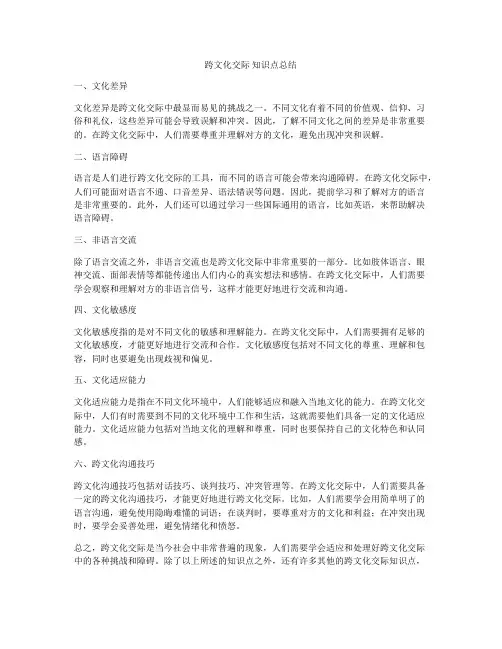
跨文化交际知识点总结一、文化差异文化差异是跨文化交际中最显而易见的挑战之一。
不同文化有着不同的价值观、信仰、习俗和礼仪,这些差异可能会导致误解和冲突。
因此,了解不同文化之间的差异是非常重要的。
在跨文化交际中,人们需要尊重并理解对方的文化,避免出现冲突和误解。
二、语言障碍语言是人们进行跨文化交际的工具,而不同的语言可能会带来沟通障碍。
在跨文化交际中,人们可能面对语言不通、口音差异、语法错误等问题。
因此,提前学习和了解对方的语言是非常重要的。
此外,人们还可以通过学习一些国际通用的语言,比如英语,来帮助解决语言障碍。
三、非语言交流除了语言交流之外,非语言交流也是跨文化交际中非常重要的一部分。
比如肢体语言、眼神交流、面部表情等都能传递出人们内心的真实想法和感情。
在跨文化交际中,人们需要学会观察和理解对方的非语言信号,这样才能更好地进行交流和沟通。
四、文化敏感度文化敏感度指的是对不同文化的敏感和理解能力。
在跨文化交际中,人们需要拥有足够的文化敏感度,才能更好地进行交流和合作。
文化敏感度包括对不同文化的尊重、理解和包容,同时也要避免出现歧视和偏见。
五、文化适应能力文化适应能力是指在不同文化环境中,人们能够适应和融入当地文化的能力。
在跨文化交际中,人们有时需要到不同的文化环境中工作和生活,这就需要他们具备一定的文化适应能力。
文化适应能力包括对当地文化的理解和尊重,同时也要保持自己的文化特色和认同感。
六、跨文化沟通技巧跨文化沟通技巧包括对话技巧、谈判技巧、冲突管理等。
在跨文化交际中,人们需要具备一定的跨文化沟通技巧,才能更好地进行跨文化交际。
比如,人们需要学会用简单明了的语言沟通,避免使用隐晦难懂的词语;在谈判时,要尊重对方的文化和利益;在冲突出现时,要学会妥善处理,避免情绪化和愤怒。
总之,跨文化交际是当今社会中非常普遍的现象,人们需要学会适应和处理好跨文化交际中的各种挑战和障碍。
除了以上所述的知识点之外,还有许多其他的跨文化交际知识点,比如文化适应、文化冲突解决等等。
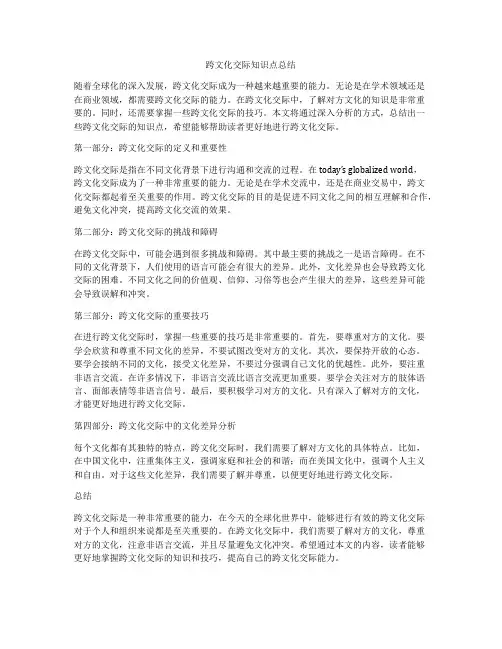
跨文化交际知识点总结随着全球化的深入发展,跨文化交际成为一种越来越重要的能力。
无论是在学术领域还是在商业领域,都需要跨文化交际的能力。
在跨文化交际中,了解对方文化的知识是非常重要的。
同时,还需要掌握一些跨文化交际的技巧。
本文将通过深入分析的方式,总结出一些跨文化交际的知识点,希望能够帮助读者更好地进行跨文化交际。
第一部分:跨文化交际的定义和重要性跨文化交际是指在不同文化背景下进行沟通和交流的过程。
在today’s globalized world,跨文化交际成为了一种非常重要的能力。
无论是在学术交流中,还是在商业交易中,跨文化交际都起着至关重要的作用。
跨文化交际的目的是促进不同文化之间的相互理解和合作,避免文化冲突,提高跨文化交流的效果。
第二部分:跨文化交际的挑战和障碍在跨文化交际中,可能会遇到很多挑战和障碍。
其中最主要的挑战之一是语言障碍。
在不同的文化背景下,人们使用的语言可能会有很大的差异。
此外,文化差异也会导致跨文化交际的困难。
不同文化之间的价值观、信仰、习俗等也会产生很大的差异,这些差异可能会导致误解和冲突。
第三部分:跨文化交际的重要技巧在进行跨文化交际时,掌握一些重要的技巧是非常重要的。
首先,要尊重对方的文化。
要学会欣赏和尊重不同文化的差异,不要试图改变对方的文化。
其次,要保持开放的心态。
要学会接纳不同的文化,接受文化差异,不要过分强调自己文化的优越性。
此外,要注重非语言交流。
在许多情况下,非语言交流比语言交流更加重要。
要学会关注对方的肢体语言、面部表情等非语言信号。
最后,要积极学习对方的文化。
只有深入了解对方的文化,才能更好地进行跨文化交际。
第四部分:跨文化交际中的文化差异分析每个文化都有其独特的特点,跨文化交际时,我们需要了解对方文化的具体特点。
比如,在中国文化中,注重集体主义,强调家庭和社会的和谐;而在美国文化中,强调个人主义和自由。
对于这些文化差异,我们需要了解并尊重,以便更好地进行跨文化交际。
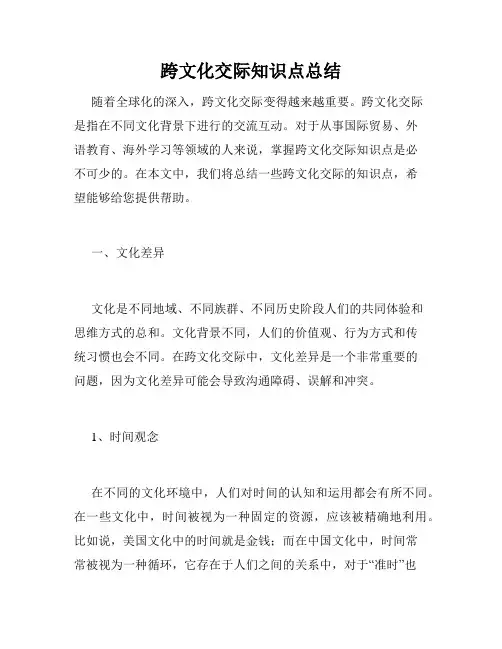
跨文化交际知识点总结随着全球化的深入,跨文化交际变得越来越重要。
跨文化交际是指在不同文化背景下进行的交流互动。
对于从事国际贸易、外语教育、海外学习等领域的人来说,掌握跨文化交际知识点是必不可少的。
在本文中,我们将总结一些跨文化交际的知识点,希望能够给您提供帮助。
一、文化差异文化是不同地域、不同族群、不同历史阶段人们的共同体验和思维方式的总和。
文化背景不同,人们的价值观、行为方式和传统习惯也会不同。
在跨文化交际中,文化差异是一个非常重要的问题,因为文化差异可能会导致沟通障碍、误解和冲突。
1、时间观念在不同的文化环境中,人们对时间的认知和运用都会有所不同。
在一些文化中,时间被视为一种固定的资源,应该被精确地利用。
比如说,美国文化中的时间就是金钱;而在中国文化中,时间常常被视为一种循环,它存在于人们之间的关系中,对于“准时”也有一些灵活的理解。
意大利、西班牙等南欧国家虽然有严谨的公共时间表,但在私人交往中强调情感和人际关系,在时间管理上相对宽松和弹性。
了解不同文化的时间概念,可以帮助我们更好地把握时间、精确地计划和实施任务,同时也能够避免因时间观念差异导致的误解和冲突。
2、礼仪习惯不同的文化中,人们对礼节和礼仪也会有所差异。
在日本、韩国等文化中,人们注重礼节和尊重他人,他们有很多规范和习惯需要遵守,比如在进屋时要脱鞋、在用餐时要用筷子等等。
在教堂、公共场所、重大活动等地区域中,西方文化中介绍穿着正式,男士要穿西服领带。
如果在跨文化交际中忽视和破坏这些礼仪和习惯,会引起对方的不满,降低你自己的形象和信誉度。
因此,尊重别人的文化习惯和传统礼仪是跨文化交际中一个很重要的方面。
3、语言差异不同的文化中,语言的表达方式也会有所不同。
中式英语且各地口音,甚至不同文化中的口头禅和惯用语,都可能会导致跨文化交际中的不同理解和误解。
比如,在西方国家中,对别人的称呼往往比较简洁明了,而在亚洲一些国家中,对别人的称呼往往会比较热情和亲切;在外国企业中,重要的决策和安排都可能会用英语或其他国际语言来表达,导致语言差异的问题尤为突出。
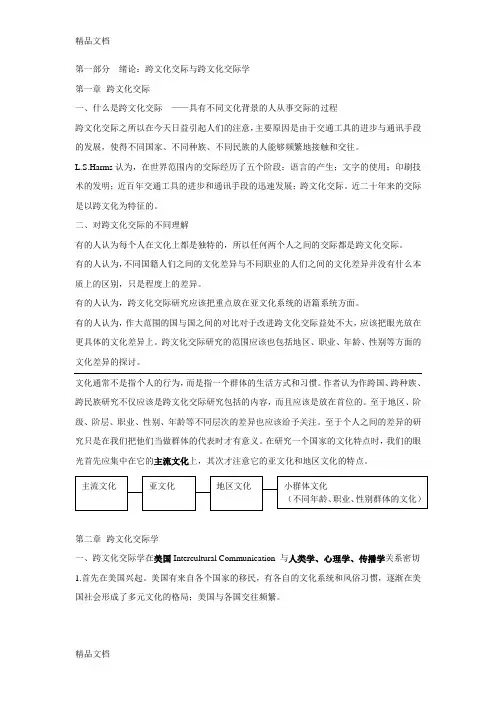
第一部分绪论:跨文化交际与跨文化交际学第一章跨文化交际一、什么是跨文化交际——具有不同文化背景的人从事交际的过程跨文化交际之所以在今天日益引起人们的注意,主要原因是由于交通工具的进步与通讯手段的发展,使得不同国家、不同种族、不同民族的人能够频繁地接触和交往。
L.S.Harms认为,在世界范围内的交际经历了五个阶段:语言的产生;文字的使用;印刷技术的发明;近百年交通工具的进步和通讯手段的迅速发展;跨文化交际。
近二十年来的交际是以跨文化为特征的。
二、对跨文化交际的不同理解有的人认为每个人在文化上都是独特的,所以任何两个人之间的交际都是跨文化交际。
有的人认为,不同国籍人们之间的文化差异与不同职业的人们之间的文化差异并没有什么本质上的区别,只是程度上的差异。
有的人认为,跨文化交际研究应该把重点放在亚文化系统的语篇系统方面。
有的人认为,作大范围的国与国之间的对比对于改进跨文化交际益处不大,应该把眼光放在更具体的文化差异上。
跨文化交际研究的范围应该也包括地区、职业、年龄、性别等方面的文化差异的探讨。
文化通常不是指个人的行为,而是指一个群体的生活方式和习惯。
作者认为作跨国、跨种族、跨民族研究不仅应该是跨文化交际研究包括的内容,而且应该是放在首位的。
至于地区、阶级、阶层、职业、性别、年龄等不同层次的差异也应该给予关注。
至于个人之间的差异的研究只是在我们把他们当做群体的代表时才有意义。
在研究一个国家的文化特点时,我们的眼光首先应集中在它的主流文化上,其次才注意它的亚文化和地区文化的特点。
第二章跨文化交际学一、跨文化交际学在美国Intercultural Communication 与人类学、心理学、传播学关系密切1.首先在美国兴起。
美国有来自各个国家的移民,有各自的文化系统和风俗习惯,逐渐在美国社会形成了多元文化的格局;美国与各国交往频繁。
2.Edwar Hall 《无声的语言》跨文化交际学的奠基之作。
认为不同文化背景的人们在使用时间、空间表达意义方面表现出明显的差异。
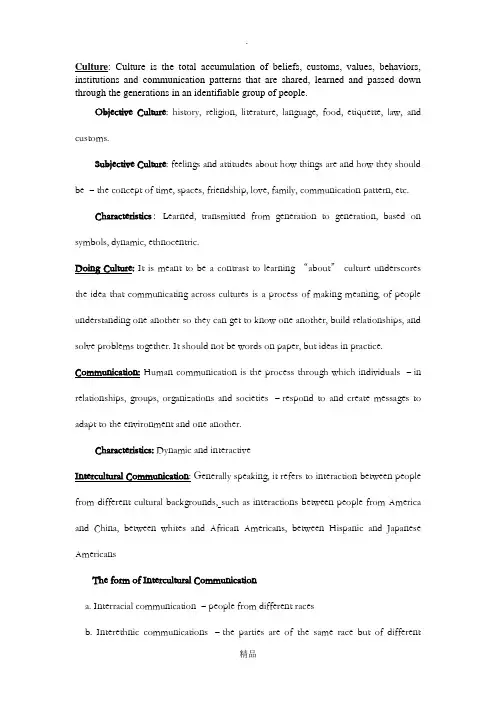
Culture: Culture is the total accumulation of beliefs, customs, values, behaviors, institutions and communication patterns that are shared, learned and passed down through the generations in an identifiable group of people.Objective Culture: history, religion, literature, language, food, etiquette, law, and customs.Subjective Culture: feelings and attitudes about how things are and how they should be –the concept of time, spaces, friendship, love, family, communication pattern, etc.Characteristics:Learned, transmitted from generation to generation, based on symbols, dynamic, ethnocentric.Doing Culture: It is meant to be a contrast to learning “about” culture underscores the idea that communicating across cultures is a process of making meaning, of people understanding one another so they can get to know one another, build relationships, and solve problems together. It should not be words on paper, but ideas in practice. Communication: Human communication is the process through which individuals –in relationships, groups, organizations and societies –respond to and create messages to adapt to the environment and one another.Characteristics: Dynamic and interactiveIntercultural Communication: Generally speaking, it refers to interaction between people from different cultural backgrounds, such as interactions between people from America and China, between whites and African Americans, between Hispanic and Japanese AmericansThe form of Intercultural Communicationa. Interracial communication –people from different racesb. Interethnic communications –the parties are of the same race but of differentethnic origins.c. Intercultural communication –communication between members of the sameculture, in which one or both of the participants hold dual or multiple memberships.(gay, disabled, Mexican American, African American, or female)Communication Competence (ICC competence)The cognitive component –how much one know about communication.The affective component –one’s motivation to approach or avoid communicationThe behavior component –the skills one has to interact competently. Perception: Perception is a cognitive process in which we attach meaning to objects, symbols, people and behavior in order to make sense of them.Pattern of Thought: The way people in a culture think influences the way they interpret strangers’ messages.World views: The grid (decentralized. This pattern does not have a fixed center)The radiating star (highly centralized. In this pattern important things are at the center and everything else radiates out from the center)The inside/ outside pattern (圈子)female maleprivate publichome market, mosque, coffee housethe outside is plain, not welcoming, even forbidding. The walls are thick to protect what is inside.highly centralized pattern: important people sit in the front middle;decentralized pattern: people sit equally.Stereotyping: People generalize to make sense of his experience. The result of the process of over generalizing based on limited or inaccurate information.The classification of stereotypes1. Negative stereotype of other cultures: Prejudice (severe prejudice)2. Positive stereotype of one’s own culture: Cultural superiority Characteristics: universal, unavoidable, stable, variable, ethnocentrismHigh context communication & Low context communicationHC culture (察言观色): Relies mainly on the physical context or the relationship for information, with little explicitly encoded.LC culture: provide most of the information in the explicit code itself.Perception: Perception is a cognitive process in which we attach meaning to objects, symbols, people and behavior in order to make sense of them.High contact and low contact culture:In high contact cultures people want to get close enough to one another and to objects to sense them in these ways.People in these countries stand closer, touch more, engage in more eye contact and speak more loudly than people do in lower-contact cultures.In a low contact cultures, people rely more on sight, and especially sight at a far distance. People are most likely to stand a certain distance away to get the wholepicture, without actually feeling or sensing the other person’s body heat or subtle smell.So in low contact culture as America, one is taught not to breathe on people.However, this visual space seems unfriendly and indifferent to those from high contact cultures, which favor tactile space.When a person from a high contact culture goes to a low contact culture, he or she is likely to feel that people are cold, lack human warmth, and are indifferent and pay no attention to them.low-contact: Asia ; moderate-contact: Australia, Northern Europe, United States high-contact: South America, Mediterranean, the Arab worldLarge and smell Power Distancespower distance is an attempt to measure cultural attitudes about inequality in social relationships.In high power distance cultures, position in a hierarchy is considered to be natural and important. People are expected to show only positive emotions to others with high status and to display negative emotions to those with low status; tend todecrease gaze in the presence of powerful people.Low Power Distance Culture: Minimize and eliminate the differences in power and status; more emotional display, increase the amount of gaze. People believe that the differences in power between boss and workers should be reduced and not mphasized.Individualism VS CollectivismThe individualism index measures the extent to which the interests of the individual are considered to be more important than the interests of the group. People from individualist cultures are more likely to act on principles that apply to everyone, principles that are universal and apply to associates and strangers alike.Collectivists are not unprincipled, but when making decisions they tend to give a higher priority to relationships than individualists do. They expect people who are involved in a group relationship to have duties and obligations to one another.Masculinity (Toughness) VS Femininity (Tenderness)Masculinity means everyone in society embraces values that have traditionally been associated with men, that is assertiveness, competitiveness and toughness. On the feminine side of the scale we find societies in which people generally embrace values that have traditionally been labeled as feminine, that is modesty, cooperation and tenderness. Strong and weak Uncertainty AvoidanceThe Uncertainty Avoidance Index seeks to measure the extent to which people in a particular society are able to tolerate the unknowns of life. In high uncertainty avoidance countries people experience more stress and a sense of urgency as they go through their daily routines. Relationships are guided by strict rules. People from low uncertainly avoidance countries do not have a strong need to control things, people, and events by clearly defining and categorizing them. Relationships are guided by strict rules.Intercultural CommunicationIntercultural CommunicationGenerally speaking, it refers to interaction between people from different cultural backgrounds, such as interactions between people from America and China, between whites and African Americans, between Hispanic and Japanese Americans The form of Intercultural Communicationa. Interracial communication –people from different racesb. Interethnic communications –the parties are of the same race but of different ethnic origins.c. Intracultural communication –communication between members of the sameculture, in which one or both of the participants hold dual or multiple memberships.(gay, disabled, Mexican American, African American, or female)Language&CulturePeople pay attention to basic language in cross-culture communication because of the essential role these codes play in communication and they are part of object culture.The same word may stir up different associations in people under different cultural background, e.g. the word “dog”. In eastern culture, dogs are dirty, brutal and stupid. But in western culture, dogs are lovely, loyal and obedient. They are faithful friends andcompassionate animals.Language reflects culture. Language expresses cultural reality, reflects the people’s attitudes, beliefs, world outlooks, etc. For example, American businessmen often encode their meanings in metaphors and images from these sports.Chinese traditional sport culture emphasizes the harmony between human beings and oneness between man and nature. It is morality, benevolence, entertainment and longevity. But western sports culture is competition and sportsmanship.Culture shock: Troublesome feelings such as depression, loneliness, confusion, inadequacy, hostility, frustration, and tension, caused by the loss of familiar cues from the home culture.U-Curuemodel: Excitement→Confusion→Frustration→Effectiveness→Appreciation如有侵权请联系告知删除,感谢你们的配合!。
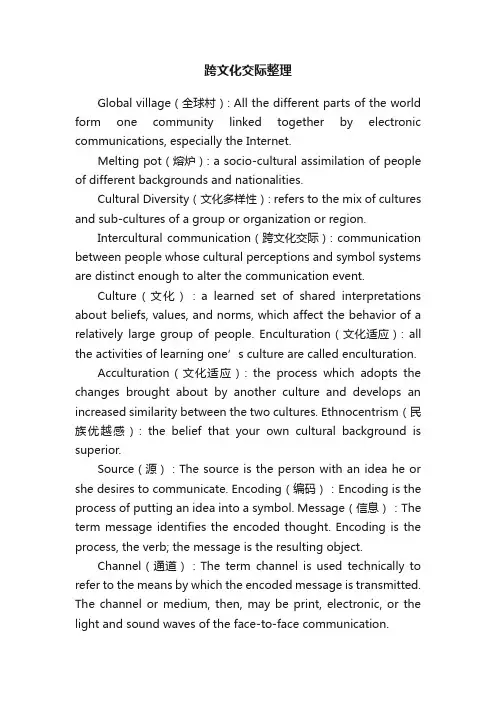
跨文化交际整理Global village(全球村): All the different parts of the world form one community linked together by electronic communications, especially the Internet.Melting pot(熔炉): a socio-cultural assimilation of people of different backgrounds and nationalities.Cultural Diversity(文化多样性): refers to the mix of cultures and sub-cultures of a group or organization or region.Intercultural communication(跨文化交际): communication between people whose cultural perceptions and symbol systems are distinct enough to alter the communication event.Culture(文化):a learned set of shared interpretations about beliefs, values, and norms, which affect the behavior of a relatively large group of people. Enculturation(文化适应): all the activities of learning one’s culture are called enculturation.Acculturation(文化适应): the process which adopts the changes brought about by another culture and develops an increased similarity between the two cultures. Ethnocentrism(民族优越感): the belief that your own cultural background is superior.Source(源):The source is the person with an idea he or she desires to communicate. Encoding(编码):Encoding is the process of putting an idea into a symbol. Message(信息):The term message identifies the encoded thought. Encoding is the process, the verb; the message is the resulting object.Channel(通道):The term channel is used technically to refer to the means by which the encoded message is transmitted. The channel or medium, then, may be print, electronic, or the light and sound waves of the face-to-face communication.Noise(干扰):The term noise technically refers to anything that distorts the message the source encodes.Receiver(接收器):The receiver is the person who attends to the message. Decoding(解码):Decoding is the opposite process of encoding and just as much an active process. The receiver is actively involved in the communication process by assigning meaning to the symbols received.Receiver response(接收者反应):Receiver response refers to anything the receiver does after having attended to and decoded the message.Feedback(反馈):Feedback refers to that portion of the receiver response of which the source has knowledge and to which the source attends and assigns meaning. Context(语境):Generally, context can be defined as the environment in which the communication takes place and which helps define the communication. Pragmatics(语用学): the study of the effect that language has on human perceptions and behavior.Semantics(语义学): the study of the meaning of words.Denotation(本义): the literal meaning or definition of a word --- the explicit, particular, defined meaning.Connotation(转义): the suggestive meaning of a word --- all the values, judgments, and beliefs implied by a word, the historical and associative accretion of the unspoken significance behind the literal meaning.Taboo(禁忌): some objects, words or actions that are avoided by a particular group of people, or in certain culture for religious or social reasons.Euphemism(委婉语): the act of substituting a mild, indirect, or vague term for one considered harsh, blunt, or offensive Chronemics(时间学): The study of how people perceiveand use time. Monochronic time: paying attention to and doing only one thing at a time. Polychronic time being involved with many things at once.Proxemics(空间学): the perception and use of space.Kinetics(身势学): the study of body languageParalanguage(副语言): involving sounds but not words and lying between verbal and nonverbal communication.A planetary culture(行星文化): a culture that integrates eastern mysticism with western science and rationalism Intercultural person(跨文化的人): represents someone whose cognitive, affective, and behavioral characteristics are not limited but open to growth beyond the psychological parameters of his or her own culture园林工人:landscape engineer 理发师:tonsorial artist 清洁工:sanitation engineer 补鞋匠:shoe rebuilder 发疯的:soft in the head 撒谎:reckless disregard for truth 偷窃:to take things without permission 劳资关系紧张:industrial climate天网恢恢...:justice has long arms 棋逢对手:diamond cut diamond金玉良言:golden saying 肥缺:fat office 船到桥头自然直:you will cross the bridge when you get to it 宁为鸡头,勿为牛后:better be the head of a dog than the tail of a lion 牛饮:drink likea fish 如履薄冰:tread upon eggs1.What are the four trends that lead to the development of the global village? Convenient transportation system; innovative communication system;economic globalization; widespread migrations2. What are the three ingredients of culture?Artifacts (the material and spiritual products people produce);behavior (what they do) ;concepts (beliefs, values, world views…) (what they t hink) 3.Characteristics of culture?Culture is shared; culture is learned; culture is dynamic; culture is ethnocentric4.Characteristics of communication?Communication is dynamic; irreversible; symbolic; systematic; transactional; Contextual5. How is gender different from sex?Sex: biological、permanent、with an individual property.Gender: socially-constructed、varied over time and across cultures、with a socialand relational quality.6.. How is Chinese addressing different from American addressing?The Americans tend to address only with given names while the Chinese may use the full name. Even when the full names are used in some formal accessions by the Americans, the given names would be placed before the surname while the Chinese would do the opposite.Chinese often extend kinship terms to people not related by blood or marriage while the Americans seldom do so.The Chinese tend to address the people with titles but in English only a few occupation or titles could be used.7.What are the different features of M-time and P-time?M-time is noted for its emphasis on schedules, segmentation, punctuality and promptness. It features one event at a time and time is perceived as a linear structure. P-time is less rigid and clock-bound. It features several activities at the same time and time is perceived as more flexible and more human-centered.8. What has influenced the gender socialization?According to researchers, there are two primary influenceson gender socialization: family communication, particularly between mothers and children, and recreational interaction among children.9.What are the American/Chinese cultural values like in terms of Cultural Orientation put forward by Kluckhohn and Strodtbeck? (ppt中的补充内容)As far as the human nature is concerned, American culture holds that it is evil but perfectible through hard work. As to the relation of man to nature, they think mankind can conquer nature. They also have a linear time concept and therefore they are future-oriented. They focus on doing and think that only actions can solve the problem. They are quite individualistic and therefore they focus less on the benefits of the group.As far as the human nature is concerned, Chinese culture holds that it is good but corruptible without proper education. As to the relation of man to nature, they think mankind can live in harmony with nature. They also have a cyclical time concept and therefore they are past-oriented. They have a being-and-becoming attitude towards activity and think that man should keep an inner peace as nothing is eternal. They are quite collective and therefore they focus more on the benefits of the group.)。
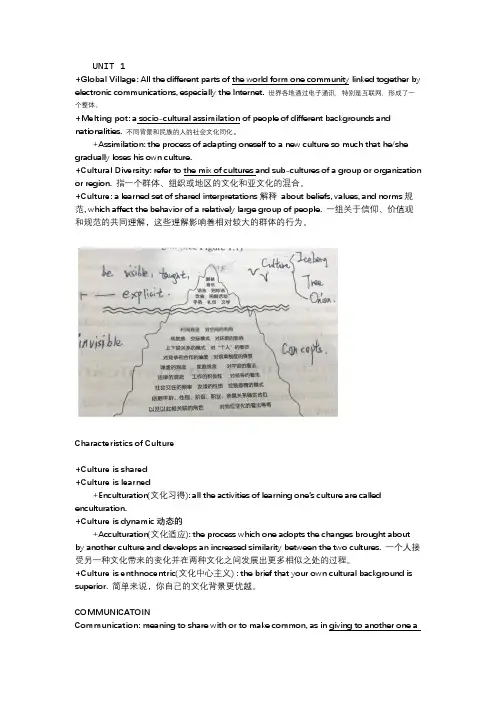
UNIT 1+Global Village: All the different parts of the world form one community linked together by electronic communications, especially the Internet. 世界各地通过电子通讯,特别是互联网,形成了一个整体。
+Melting pot: a socio-cultural assimilation of people of different backgrounds and nationalities. 不同背景和民族的人的社会文化同化。
+Assimilation: the process of adapting oneself to a new culture so much that he/she gradually loses his own culture.+Cultural Diversity: refer to the mix of cultures and sub-cultures of a group or organization or region. 指一个群体、组织或地区的文化和亚文化的混合。
+Culture: a learned set of shared interpretations解释about beliefs, values, and norms规范, which affect the behavior of a relatively large group of people. 一组关于信仰、价值观和规范的共同理解,这些理解影响着相对较大的群体的行为。
Characteristics of Culture+Culture is shared+Culture is learned+Enculturation(文化习得): all the activities of learning one’s culture are called enculturation.+Culture is dynamic动态的+Acculturation(文化适应): the process which one adopts the changes brought about by another culture and develops an increased similarity between the two cultures. 一个人接受另一种文化带来的变化并在两种文化之间发展出更多相似之处的过程。
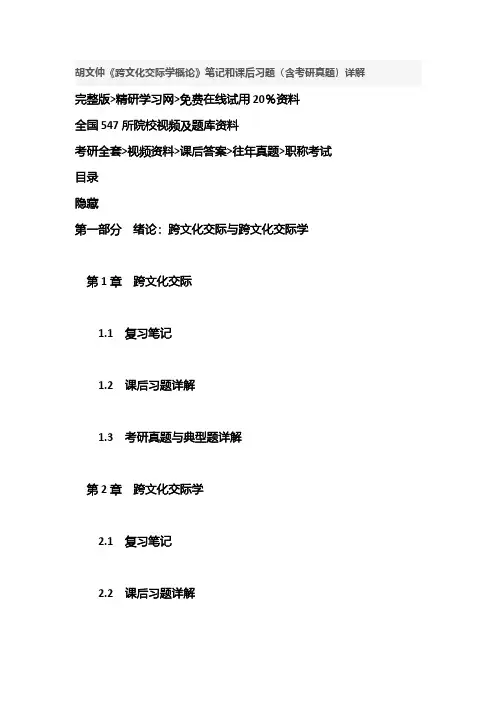
胡文仲《跨文化交际学概论》笔记和课后习题(含考研真题)详解完整版>精研学习网>免费在线试用20%资料全国547所院校视频及题库资料考研全套>视频资料>课后答案>往年真题>职称考试目录隐藏第一部分绪论:跨文化交际与跨文化交际学第1章跨文化交际1.1复习笔记1.2课后习题详解1.3考研真题与典型题详解第2章跨文化交际学2.1复习笔记2.2课后习题详解2.3考研真题与典型题详解第二部分基本概念:文化与交际第3章文化的定义与特性3.1复习笔记3.2课后习题详解3.3考研真题与典型题详解第4章交际4.1复习笔记4.2课后习题详解4.3考研真题与典型题详解第三部分跨文化交际的过程第5章语言交际5.1复习笔记5.2课后习题详解5.3考研真题与典型题详解第6章非语言交际6.1复习笔记6.2课后习题详解6.3考研真题与典型题详解第7章社会交往7.1复习笔记7.2课后习题详解7.3考研真题与典型题详解第8章人际关系8.1复习笔记8.2课后习题详解8.3考研真题与典型题详解第9章经营管理9.1复习笔记9.2课后习题详解9.3考研真题与典型题详解第四部分跨文化交际的核心第10章价值观10.1复习笔记10.2课后习题详解10.3考研真题与典型题详解第五部分提高跨文化意识第11章跨文化交际的障碍11.1复习笔记11.2课后习题详解11.3考研真题与典型题详解第12章文化休克与跨文化训练12.1复习笔记12.2课后习题详解12.3考研真题与典型题详解内容简介隐藏本书是胡文仲《跨文化交际学概论》教材的学习辅导书,主要包括以下内容:1.整理名校笔记,浓缩内容精华。
在参考了国内外名校名师讲授该教材的课堂笔记基础上,复习笔记部分对该章的重难点进行了整理。
因此,本书的内容几乎浓缩了该教材的知识精华。
2.解析课后习题,提供详尽答案。
本书参考了该教材的国内外配套资料和其他教材的相关知识对该教材的课(章)后习题进行了详细的分析和解答,并对相关重要知识点进行了延伸和归纳。
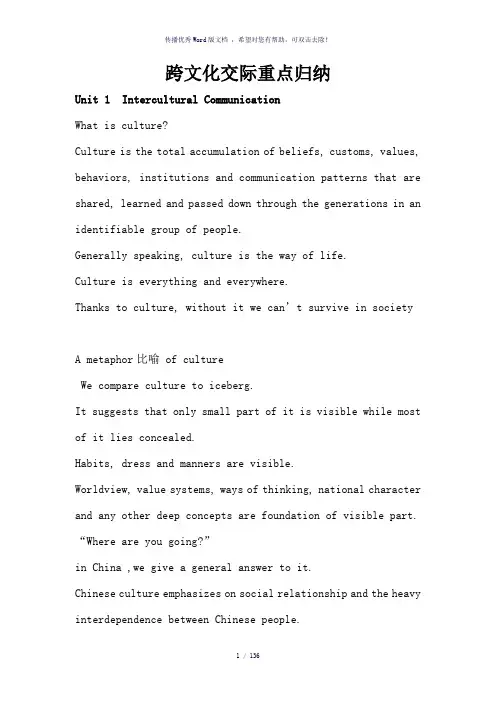
跨文化交际重点归纳Unit 1 Intercultural CommunicationWhat is culture?Culture is the total accumulation of beliefs, customs, values, behaviors, institutions and communication patterns that are shared, learned and passed down through the generations in an identifiable group of people.Generally speaking, culture is the way of life.Culture is everything and everywhere.Thanks to culture, without it we can’t survive in societyA metaphor比喻 of cultureWe compare culture to iceberg.It suggests that only small part of it is visible while most of it lies concealed.Habits, dress and manners are visible.Worldview, value systems, ways of thinking, national character and any other deep concepts are foundation of visible part. “Where are you going?”in China ,we give a general answer to it.Chinese culture emphasizes on social relationship and the heavy interdependence between Chinese people.In western countries, it may be interpreted as an intrusion into one’s privacy.The underlying individual-oriented relationship is the invisible part of the iceberg.exercise1. If you are a tourist guide, what are you expected to say when you are showing the foreign visitors to another site?A. This way, please.B. Come here, please.C. Follow me, please.D. Move on.2. A visitor stops you in the corridor of your head-office probably to ask for the way. What is your most likely reply to the visitor’s “Excuse me”?A. What’s the matter?B. Yes?C. That’s all right.D. Don’t worry.3. At a fair, a visitor, accidentally having knocked down your poster, says, “I’m terribly sorry.” What should you reply?A. It doesn’t matter.B. Never mind.C. Don’t worry.D. That’s all right.What is Intercultural communication?“Intercultural communication is contact between persons whoidentify themselves as distinct from one another in cultural terms.” (Collier & Thomas, 1998)intercultural communication refers to any communication between two members of any cultural communities. (Samovar & Porter)To further understand “intercultural communication”, please read the section of “Intercultural Communication Reading” on P.2 and answer the questions:1 In the story, why does Pete could not communicate well with Chinese students?Language problemCulture problemThe way Pete handled the intercultural communication situation 2 What are the major barriers in intercultural communication? Language difference.(If we understand others’ language or dialect, but not their communication rules, we can made fluent fools of ourselves.) Nonverbal communication: gestures, postures, facial expression etc.Stereotypes: like culture, religion, idea, value, etc.Watch a video and get a deeper understanding.Classifications of Communicationverbal /nonverbalDirect /indirectInterpersonal / interorganizational / mass media-based Intracultural /interculturalIntrapersonal / interpersonal/…Case studyRead the passage of “ an Intercultural Classroom”. This is the beginning of this passage:It was a hot day. Since it was still too early to use the air-conditioner, according to the regulations of the university, every class kept its door open to make the classroom cooler. While I was lecturing on Chinese grammar in Class 4, waves of laughter came from the neighboring Class 5. A German student named Stephen raised his hand and stood up. “The laughter from Class 5 is bothering us. I think we should go to their class to protest,” he said….1 How many different solutions did Class 4 propose?2 what is the mode of communication favored by Asians? What cultural values underlie it?Asian people are very courteous and indirect in their communications. They put great emphasis on group harmony, theyare very tolerant, even when they are offended. These collectivistic values, shaped by Confusion teachings, were spread from China to many Asian countries.3 what is the mode of communication favored by Westerners? What cultural values underlie it?Westerners are generally very direct and frank in their mode of communication. And they have a strong sense of protecting their own rights. Individualistic values are the underlying principles governing their behavior.Classroom activity 11. Read the story on P1 and answer: Why do you think the driver is asking for $50 instead of $32.5?2. Work in groups and write down 5 ways to deal with the situation.Some likely interpretationsThe taxi driver is trying to cheat Lee.extra charges for luggage that Lee doesn’t know about. Extra charges for tolls that Lee doesn’t know.There is an honest misunderstanding.L ee misunderstood what the driver said, or didn’t hear what he said clearly.The driver has included a tip for himself –an unreasonably large one.Culture NoteTaxi charges: in taxis in the us, it is quite normal to have a small extra charge for each of luggage. In the us there are also sometimes tolls for bridges, tunnels and certain roads. and the taxi driver will pay these first and then add them to the cost of the ride.Tipping: in the us it is normal to add a tip of 10%-15% to the cost of a taxi ride. (tipping is not normal in fast-food restaurants where customs get their own food.Taxis in the Us: while taxis can often be found at Us airports, taxis are rare in all but the largest American cities, and to get a taxi people often need to call a taxi company. This is because most Americans drive their cars. (in large cities, taxi drivers are often immigrants form other countries who do not speak English as their first language.)Classroom activity 2Read Letter to Fran: Not Eating and answer the following questions.1. Why did Nancy eat so little?2. Tell the possible reasons for Nancy’s problem.Possible reasonsOn the whole, American cooking tends to be somewhat more bland than the cooking in most parts of China.Some westerners have allergic reactions to MSG(often used in Chinese cooking) and get headaches if they eat food containing it.Some Christians won’t drink alcoholic beverages.Read Fran’s Response: Not Eating after class and get more information.Discuss the differences of table manners between Chinese and Westerners.Chinese people often use words like color 、smell 、taste、shape to describe the food.Westerners usually pay more attention to the calories、vitamins、proteins and so on.we would invite many people “the more the better”If the host respect you ,he will give you a seat at first and sit on the left chair .The host will prepare all the things ready. The host will get delicious food into the guest’s bowl .Westerners would like to keep quiet. They regard the right as a symbol of respect.The host will let the guests choose what to eat or drink.Individualist and CollectivistWhat are the characteristics of Individualist and Collectivist?Classroom activity 3Read the passage Individualist and Collectivist Cultures and finish the following tasks.What are some differences between an individualist culture and a collectivist one?find out ways of how do Chinese show individualism and how do westerners show their collectivism. You may need to supply your points with examples.Assignment:Review unit 1 and Preview unit 2Work in teams of 6 and deliver a presentation on following topics:What are differences between an individualist culture and a collectivist one?find out ways of how do Chinese show individualism and how do westerners show their collectivism. You may need to supply your points with examples.Unit 2Review: Interpretation解释、翻译 of greetings上哪去?Where are you going?It’s none of your business!去哪啦? Where have you been?吃过了吗?Have you had your meal?Are you going to invite me to dinner?Acceptable Greetings中文出去呀?吃饭去?回来了?忙着呢?忙什么呢?在洗车呀?这衣服真漂亮,新买的吧?你看起来气色不错。
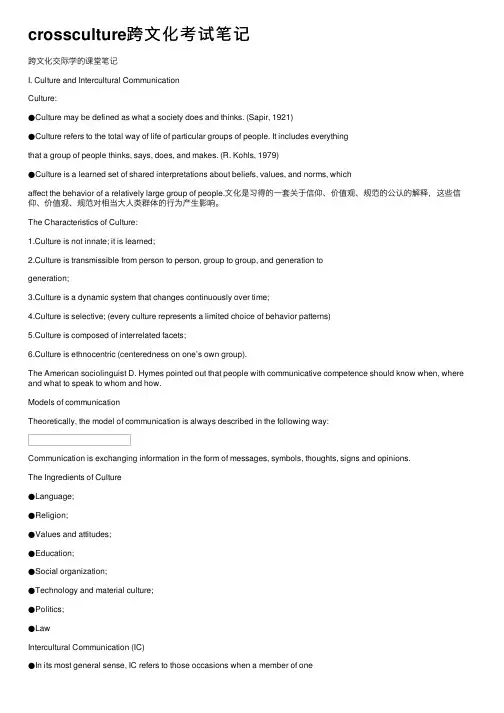
crossculture跨⽂化考试笔记跨⽂化交际学的课堂笔记I. Culture and Intercultural CommunicationCulture:●Culture may be defined as what a society does and thinks. (Sapir, 1921)●Culture refers to the total way of life of particular groups of people. It includes everythingthat a group of people thinks, says, does, and makes. (R. Kohls, 1979)●Culture is a learned set of shared interpretations about beliefs, values, and norms, whichaffect the behavior of a relatively large group of people.⽂化是习得的⼀套关于信仰、价值观、规范的公认的解释,这些信仰、价值观、规范对相当⼤⼈类群体的⾏为产⽣影响。
The Characteristics of Culture:1.Culture is not innate; it is learned;2.Culture is transmissible from person to person, group to group, and generation togeneration;3.Culture is a dynamic system that changes continuously over time;4.Culture is selective; (every culture represents a limited choice of behavior patterns)5.Culture is composed of interrelated facets;6.Culture is ethnocentric (centeredness on one’s own group).The American sociolinguist D. Hymes pointed out that people with communicative competence should know when, where and what to speak to whom and how.Models of communicationTheoretically, the model of communication is always described in the following way:Communication is exchanging information in the form of messages, symbols, thoughts, signs and opinions.The Ingredients of Culture●Language;●Religion;●Values and attitudes;●Education;●Social organization;●Technology and material culture;●Politics;●LawIntercultural Communication (IC)●In its most general sense, IC refers to those occasions when a member of oneculture produces a message for consumption by a member of another culture. (p70, Samovar & Porter)●More precisely, IC refers to communication between people whose cultureperceptions and symbol systems are distinct enough to alter the communication event.(p70, Samovar & Porter)跨⽂化交际:指拥有不同⽂化认知和符号体系的⼈们之间进⾏的交际。
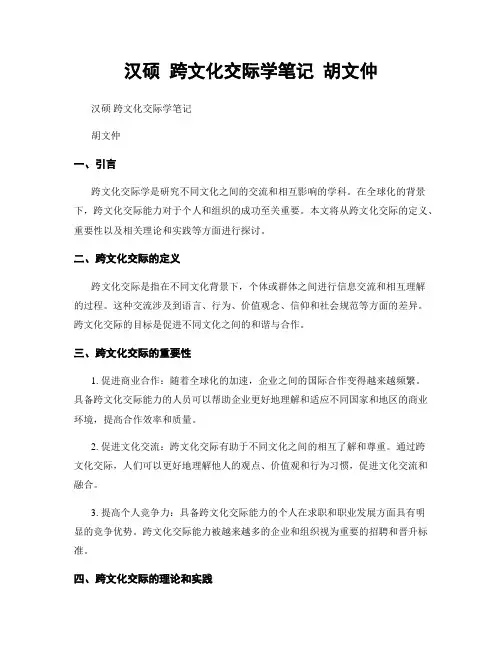
汉硕跨文化交际学笔记胡文仲汉硕跨文化交际学笔记胡文仲一、引言跨文化交际学是研究不同文化之间的交流和相互影响的学科。
在全球化的背景下,跨文化交际能力对于个人和组织的成功至关重要。
本文将从跨文化交际的定义、重要性以及相关理论和实践等方面进行探讨。
二、跨文化交际的定义跨文化交际是指在不同文化背景下,个体或群体之间进行信息交流和相互理解的过程。
这种交流涉及到语言、行为、价值观念、信仰和社会规范等方面的差异。
跨文化交际的目标是促进不同文化之间的和谐与合作。
三、跨文化交际的重要性1. 促进商业合作:随着全球化的加速,企业之间的国际合作变得越来越频繁。
具备跨文化交际能力的人员可以帮助企业更好地理解和适应不同国家和地区的商业环境,提高合作效率和质量。
2. 促进文化交流:跨文化交际有助于不同文化之间的相互了解和尊重。
通过跨文化交际,人们可以更好地理解他人的观点、价值观和行为习惯,促进文化交流和融合。
3. 提高个人竞争力:具备跨文化交际能力的个人在求职和职业发展方面具有明显的竞争优势。
跨文化交际能力被越来越多的企业和组织视为重要的招聘和晋升标准。
四、跨文化交际的理论和实践1. 文化维度理论:霍夫斯泰德提出的文化维度理论认为,不同文化之间存在着六个维度的差异,包括权力距离、个人主义与集体主义、男性气质与女性气质、不确定性规避、长期导向和短期导向。
了解和应用这些维度可以帮助人们更好地理解和适应不同文化的交际方式。
2. 跨文化沟通技巧:跨文化交际需要掌握一定的沟通技巧。
例如,要尊重对方的文化差异,避免使用具有歧视性的语言;要注意非语言沟通的重要性,如姿势、表情和眼神等;要善于倾听和提问,以促进双方的理解和沟通。
3. 跨文化冲突管理:跨文化交际中常常会出现冲突和误解。
管理跨文化冲突需要灵活应对,尊重对方的观点,善于解释和沟通,寻找共同的利益和解决方案。
五、结论跨文化交际学是一个复杂而重要的学科,对于个人和组织的成功具有重要意义。
跨文化交际祖晓梅读书笔记2019.8.141、作为第二语言教学专业课程内容应该涵盖:1)作为第二语言的汉语的语言学描述2)作为语言的汉语要素教学:语音、词汇、语法、汉字、篇章及其综合教学3)作为第二语言的汉语技能教学:听力、口语、阅读、协助机器综合教学4)语言教学原理、世界第二语言教学法发展与沿革、当今第二语言教学法发展趋势5)汉语的本质特点与汉语作为外语的教学法:历史、现状与创新6)汉语教材的编写、选用与灵活处理7)语言测试原理及汉语成绩测试试卷设计与分析8)汉语课堂教学设计以及教学活动组织与管理教材特点1)力求理论联系实际2)突出实践性和可操作性:思考题、讨论题、调查问卷、教学方法3)注重学习者个人体验:教学讨论、试验实践、批判性阅读能力4)适应不同专业方向学位攻读者教材系列1)汉语作为第二语言教学——汉语要素教学2)汉语作为第二语言教学——汉语技能教学3)跨文化交际4)第二语言习得5)国际汉语教学案例分析与点评6)中华文化与传播第一章跨文化交际概论第一节跨文化交际一、本节学习重点1、讨论重点学习跨文化交际的必要性2、跨文化交际学的历史、理论基础、内容和研究方法3、跨文化交际与汉语国际教育的关系二、影响跨文化交流的因素1、交通和通信技术的发展2、经济全球化3、人口的流动4、广泛的国际交流与合作三、跨文化交际的定义1、跨文化交际是指那些文化观念和符号系统的不同足以改变交际事件的人们之间的交流2、跨文化交际是一种流动性的和象征性的过程,涉及来自不同文化背景的人们之间的意义归因3、跨文化交际就是不同背景的人们之间的交际。
4、跨文化交际是来自不同文化背景的人们之间符号性交流的过程,有效的跨文化交际的目标是在交互的情境中给不同的个体创造共享的意义。
四、跨文化交际定义的几个重点1、不同文化背景的人们之间的交流2、通过象征符号来实现的3、是一种动态过程4、是一种双向的互动5、其目标是创建共享的意义(美国社会语言学家Tannen 《You Just Don’t Understand》)五、跨文化交际的特点1、跨文化交际主要指人与人之间面对面的交际:非语言、双向、互动vs大众传媒2、跨文化交际中涉及很多差异性:深层文化、行为方式、习俗3、跨文化交际容易引起冲突语言、交际风格、非语言行为、思维模式、社会准则、价值观4、跨文化交际的误解和冲突大多属于“善意的冲突”(well-meaning clash)5、跨文化交际常常引起情感上的强烈反应(文化休克、焦虑管理理论)6、跨文化交际是一种挑战更是一种收获第二节跨文化交际学一、定义跨文化交际既是一种社会现象,也指对这种现象进行研究的学科,“cross-cultural communication”与“intercultural communication”,文化如何影响人类行为的平行研究和对比研究,跨文化交际研究主要研究的是来自不同文化背景的人们是如何交往的,特别是面对面的交往。
跨文化交际学概论笔记一、引言跨文化交际学是研究不同文化背景下人们之间的交际行为和相互理解的学科。
它关注的是不同文化之间的差异和相似之处,以及如何在跨文化环境中进行有效的交流和互动。
本文将介绍跨文化交际学的定义、重要性以及相关的理论框架。
二、跨文化交际学的定义跨文化交际学是一门综合性学科,它研究的是在不同文化背景下人们之间的交际行为和相互理解。
跨文化交际学旨在帮助人们更好地理解和应对不同文化之间的差异,促进跨文化交流和互动的顺利进行。
三、跨文化交际学的重要性1. 促进文化交流和理解:跨文化交际学可以帮助人们更好地理解和尊重不同文化的差异,从而促进跨文化交流和理解。
2. 提高跨文化沟通的效果:通过学习跨文化交际学,人们可以了解不同文化之间的交际规则和习惯,从而提高跨文化沟通的效果。
3. 增进国际合作和发展:跨文化交际学对于促进国际合作和发展具有重要意义,可以帮助不同国家和地区之间建立良好的合作关系。
四、跨文化交际学的理论框架1. 文化维度理论:文化维度理论是跨文化交际学中的重要理论框架之一,它通过对不同文化之间的差异进行分类和比较,帮助人们更好地理解不同文化的特点和习惯。
2. 社会认知理论:社会认知理论研究人们在跨文化交际过程中的认知和理解方式,包括对他人行为的解释和理解。
3. 语言和交际行为理论:语言和交际行为理论研究语言在跨文化交际中的作用和影响,包括语言的表达方式、语言的符号和意义等。
五、跨文化交际的挑战和应对策略1. 语言障碍:不同文化之间的语言差异可能导致交流的困难,应加强语言学习和提高语言能力。
2. 文化差异:不同文化之间的差异可能导致误解和冲突,应加强对不同文化的了解和尊重。
3. 价值观差异:不同文化之间的价值观差异可能导致观念冲突,应尊重对方的价值观,并寻求共同点。
六、结论跨文化交际学的研究对于促进不同文化之间的交流和理解具有重要意义。
通过学习跨文化交际学,人们可以更好地应对跨文化环境中的挑战,促进国际合作和发展。
Unit 11 economic globalization(经济全球化):the integration of national economies into the international economy through trade, foreign direct investment, capital flows, migration, and the spread of technology.2 barter system(物物交换):exchange without money–Farming communities traded their surplus produce in exchange for products and services without the medium of money.–Human society has always traded goods across great distances.3 global village(地球村):the world form one community–All the different parts of the world form one community linked together by electronic communications, especially the Internet.4 melting pot(大熔炉):a socio-cultural assimilation of people of different backgrounds and nationalities.5 culture(文化):can been seen as shared knowledge, what people need to know in order to act appropriately in a given culture.6 cultural diversity(文化融合):refers to the mix of people from various backgrounds in the labor force with a full mix of cultures and sub-cultures to which members belong.7. Communication(交际): mean to share with or to make common, as in giving to another a part or share of your thoughts, hopes, and knowledge.8 intercultural communication(跨文化交际):communication between people whose cultural backgrounds and distinct(不同)enough to alter(改变)their communicaion。
跨文化交际P116-117 I or A (inappropriate or appropriate)1.Is it appropriate of Anna to ask Ben this question "Can we talk about us?" A2.Is it appropriate of Anna to ask Ben to tell her what makes him feel loved and close to her? A3.Is it appropriate of Anna to thank Ben for being so supportive tell Ben she fell closer ever than him. A?4.Why did Anna ask Ben "Can we talk about us?"D. She wanted to thank Ben for being supportive.5.Why was Ben reluctant to have a talk with his fiance?(声调)B. Ben thought it was pointless to talk about their healthy relationship.6.Why do women ask their partner "Can we talk about us" when their relationshipsare healthy?C. They wanted some attention./D. It is a sense of insecurity.7.How did Anna feel when Ben was reluctant to talk to her?B. Her feelings was hurt.8.Why do some women like to ask their partner "Can we talk about us"? ( 注意与6题区分)——For women, their relationship is a popular topic.9.Is it appropriated for her to ask you to landscape her garden? A10.Is it appropriated for her to ask you how much you want to do the job? I11.Is it appropriated for you to tell her "You don't have to pay me."? A12.Is it appropriated for her to pay you more than you ask for? In China, A13.Why did you agree to help her landscape her garden?D. You are being helpful.14.Why did she asked you to landscape her garden?D.She thought that it would be good to have a new garden.15.Why did she insist that you make sure "there is 200 dollars in the envelope"?B.To make sure you get what you ask for.16.What would you have done if you were the lady who asked a friend to landscapeher garden? ——I would have paid more money.(与最后一题相关)17.Why did you say "you don't have to pay me."?B.You wanted to return her a favor for helping you.18.You think that it is strange for an American because he takes cold bath and drinks boiled water. I19.If you are a man in the English speaking countries,and a lady comes into the room,you must rise to your feet. A20.If you have a question to ask your foreign teacher of English ,you may say goodbyeto him and leave immediately after you have got the answer and show your grattitude. A21.When you are eating with an English friend, you wish him,"Good appetite!" I22.Jack, a foreign student in China, called at your house and asked if you mindedhim smoking. If you hate the smell of tobacco, you may say,"Would you mind I said no?" A23.If a native speaker of English says to you,"That's a very nice coat you're wearing",you can answer it by saying,"Do you really like it?" I24.In New York Chen Ming called a taxi and said to the driver,"Would mind taking me to the airport?" I25.If you are a male and introduced to an English speaking lady,you don't take the initiative in shaking hands unless she holds out her hands first. A (与office礼节相反)26.When you break a plate in one of your friends' house,you say,"I'm awfully sorry, but I seem to have broken a plate." A27.In England you should remember that drugs may not be available without a doctor's prescription. A28.Many English houses are known only by a name. If you have difficulty in finding such a house, you may try asking the local shopkeepers. A29.Mrs. Godwin was about the same age as Li Ming's grandmother, so intimately you called her "Grandma." I30.When you give your hostress the flowers you have brought her, you should remove the wrapping paper first. In the West, I31.On his way to the school cinema, Li Hong saw Professor Janes walking to the cinema,too. Li said,"You're going to see the film,aren't you?" I32.You don't need to tip the girl who shows you to your seat in a cinema or a theatre in the UK. A33.On a cold winter day Wang Ming meet Professor Briner on his way to the library.Wang said to him,"It's rather cold,you'd better wear more clothes." I34.Betty is a foreign student in China. She met Feng Mei and said to her,"I was told that you the 200-meter race in the all-city track meet this morinig". Feng replied, "Just lucky". I35.When you want to compliment(赞美) your young English friends' new coat, you can say, "I like your new coat." A36.If you study as a graduate student in the U.S.A, you would always try to avoid telephoning your American classmates at sometimes later than 11p.m. Unless there is an emergency. A37.Wang Lin called at one of his foreign friends' house. He was really impressed by the beautiful curtains(窗帘) made by his friend's wife. He said to her,"Well.I didn't expect you could make such pretty curtains." I38.If you want borrow a typewriter(打印机) from your English friend, you say," Is there my chance of borrowing your typewriter?" A39.Mrs. Brown, in her late forties, came to the lecture,wearing a new dress. One of her students said to her, "You look nice and younger wearing this dress." I 40.It is appropriate for you to pick up food with your chopsticks for your foreign guest during dinner. A41.When you are feeling under the weather(=sick) and want to go see doctor, it is good to make an appointment before you go. A42.If you want to go see one of your American or English friends, you can do it after lunch. A43.If you are a college student and meet during the break in an academic conference an American Professor who is a friend of your supervisor's, you can go and havea talk with him as long as the break permit. A44.If when you study at a college in an English-speaking country you feel ill and therefore cannot attend lesson, you'd better go and see the doctor and ask him to write you a certificate for sick leave. A45.Dr. Smith, over 60, invited Li Bing to his birthday party. Li Bing brought hima Chinese god of longevity as a present. I(其它AB卷见网工笔记本)友情提示:本资料代表个人观点,如有帮助请下载,谢谢您的浏览!。